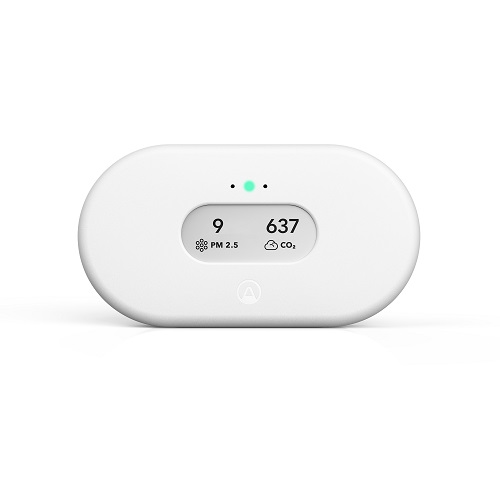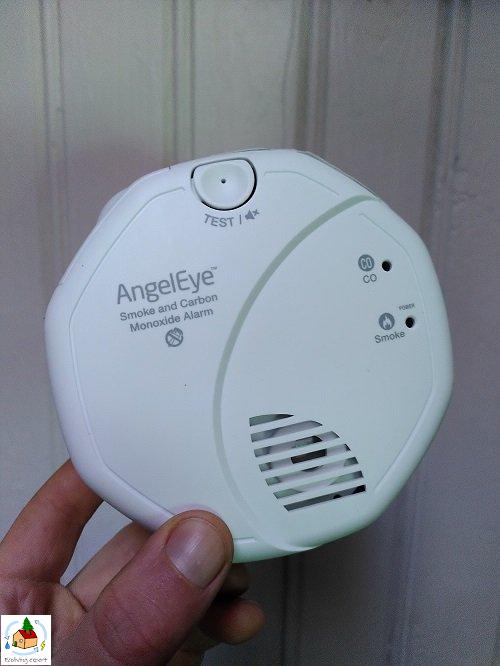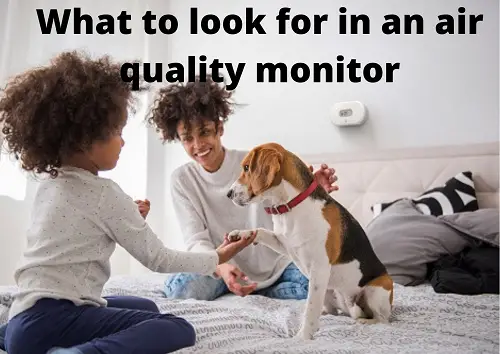
Looking to purchase an indoor air quality monitor? These are the most important measurements and features to look out for:
Essential measurements
Particulate matter (PM2.5), also known as fine dust
Important features
On top of these essential aspects, you should ask yourself the following questions:
- Am I at risk of Radon gas exposure?
- Do I need my monitor to measure carbon monoxide (CO), or do I use a separate CO monitor?
- Do I care about measuring temperature, humidity, and air pressure?
- What am I willing to spend on an air quality monitor?
- Is mold detection required?
- Am I sensitive to pollen?
- How important are the weight and size of the device?

The compounds that are essential to measure
There are many different potentially harmful compounds in the air that we breathe. Some of them are very rare while others are present almost always. The presence of certain compounds depends on many factors such as the area that you live in, the time of day, and the products that you use.
No monitor can measure all the compounds in the air. Luckily, that is not necessary. We mostly want to measure the most prevalent compounds, and only the ones relevant to us. The ones that are potentially harmful.
Since the amount of exposure to a compound determines if it is harmful to us, it is useful to measure if they are present, and in what amounts. For example, CO2 is a naturally occurring gas that is necessary for plants to grow. It is harmless to humans at normal background levels. However, when CO2 levels rise, they can pose a risk to our health.
Climate change, for example, is largely related to the amount of CO2 in the outdoor air. However, indoor CO2 levels can reach a much higher concentration. At these high levels, they can cause many health symptoms such as:
- sleepiness
- poor concentration
- increased heart rate
Because of this, we want to be able to measure, among others, the concentration of CO2 in our indoor air. The same is true for a couple of other compounds. These compounds are the most common potentially harmful compounds that are found in our indoor air:
- Carbon dioxide (CO2)
- Volatile Organic Compounds (VOCs)
- Particulate matter (PM2.5), also known as fine dust
Why measuring volatile organic compounds is a must
Volatile organic compounds (VOCs) are mostly human-made chemicals that are emitted as gas from solids or liquids. There are many different VOCs and their effects can range from highly toxic to no known negative health effects. Some VOCs have a smell, while others do not. (source)
Not all VOCs are dangerous to our health. For example, the smell of fruit (any smell really) is also caused by a VOC. VOC levels will never be zero. That is not a problem because low levels are not harmful. A good air quality monitor will indicate when your VOC levels are high and action needs to be taken.
The most common sources of harmful VOCs are:
- paint
- cleaning products
- deodorizers
- dry cleaning fluids
Potential health effects of VOC exposure
Acute health effects of VOC exposure include:
- headache, dizziness, loss of coordination, nausea, visual disorder
- irritation of eyes and respiratory tract
- allergic reactions including asthma and rhinitis
Chronic exposure to VOCs can lead to the following effects:
- damage to the kidney, liver, blood system, and central nervous system
- some VOCs may cause cancer. (Formaldehyde)
VOCs are very common and can have detrimental effects on our health. Therefore, being able to measure VOCs with our air quality monitor is a must. Most air quality monitors lump all VOCs together in one indicator. A few have a separate indicator for formaldehyde.

Formaldehyde
Formaldehyde is one of the more harmful VOCs among common indoor VOCs. It is stated by the US Environmental Protection Agency to potentially cause cancer. Therefore, some air quality monitors measure it separately.
It is a colorless, pungent-smelling gas and can be released from insulation and building materials such as composite wood. Other sources are:
- cleaning products, fabric softeners, and conditioners
- carpeting
- glues and resins
- tobacco smoke
- a type of insulation called urea-formaldehyde insulating foam (UFFI)
I think it is not necessary to measure formaldehyde separately. A normal air quality monitor that measures VOCs will also measure formaldehyde, but not show it as a separate compound. So you will get notified of high formaldehyde either way.
The exception would be when you have high VOC levels and would only want to take action if it is specifically formaldehyde. In that case, you would like a separate indicator of formaldehyde. However, I do not think this situation will come up. Just make sure to take action (increase ventilation, air out the house, turn on your air purifier) any time your monitor warns of VOCs.
Why particulate matter measurements are a must
Particulate matter consists of really small dust particles, also known as fine dust. Fine dust is especially harmful since it can more easily enter your lungs compared to regular, larger, dust particles. Fine dust is found all over the house.
Indoor particulate matter has many causes, including cooking, lighting candles, and outdoor air (coming from car exhausts).
Health effects of particulate matter
Inhaling fine dust particles can lead to several health issues such as:
- irritation of airways
- decreased lung function
- an increase in respiratory problems and asthma
- premature death in people with lung or heart disease
Unfortunately, there are no safe levels of particulate matter. It is also basically impossible to have none in your air. Therefore, in my opinion, measuring fine dust is very important. When levels start to rise, you really want to know about it so you can air out the house. If you constantly have high levels of fine dust, even when ventilating often, you should consider purchasing a good air purifier.
Data readability is important
What good would a highly advanced air quality monitor be if you can’t easily read the measurements? Luckily, most commercial monitors come with several features that make them easy to read. Those are:
- a display
- (traffic) lights
- an app
Many air quality monitors have some kind of display that shows reading per compound. They either show the few compounds they can measure directly on the screen, or they show the most relevant compounds. For example, the View Plus has a customizable display in which you can choose which compounds are being shown.

On top of that, some monitors have a traffic light function. By showing a green, orange, or red light, it tells you how your air is doing. The picture above shows a green light just above the display, excellent air quality! The Airthings monitors also switch between the different measured compounds on the display and match the traffic light with the readings.
Some monitors (again all the Airthings devices) come with an app for your phone. This app can show you the exact data over time. This is much more detailed than just what’s on the display in real time.
With the data from the app, you can discover trends in your air quality so you can adjust your habits to them. For example, because of the data, you know that the CO2 levels in your home office rise above acceptable levels after an hour. Now you can open a window after 45 minutes and prevent it.
Battery life
The battery life of your air quality monitor can be a slight annoyance. Especially when there is no option to connect the device via USB for continuous operation. The following table shows the battery life and whether they can be plugged in for continuous operation.
| Air quality monitor | Battery life | Plug-in power |
|---|---|---|
| Airthings Wave Plus | 16 months | No |
| Airthings View Plus | 12 months | Yes, USB |
| BIAOLING | 8-12 hours, rechargeable | No |
| Huma-i black (HI-150) | unknown | Yes, USB |
| Temtop M10 | 6 hours | Yes, USB |
The air quality monitors in the table above are selected based on their quality and popularity.
Radon gas exposure risk
Radon gas is a very dangerous gas that is strongly associated with an increased risk of lung cancer. However, Radon is not present everywhere. Therefore, before you choose a monitor that can measure Radon, you need to find out if your area is known for Radon risk. To find out, visit radonmap.com. For more information about Radon gas, I recommend reading my article: What is Radon? (origin, health risk, and preventive measures).
Do I need to monitor carbon monoxide?
Carbon monoxide (CO) is a dangerous gas that you absolutely need to measure at home. However, every home should already have one or more CO monitors. An air quality monitor that can measure CO is a nice addition but can be no substitute for a CO monitor.
Therefore, since you already have (or should have) several CO monitors at home, measuring CO is not an essential feature of an air quality monitor.
CO monitors are very cheap. You can find them here on amazon.com.
What is carbon monoxide, and what are the risks?
Detecting carbon monoxide (CO) is a must in every house since a high concentration is lethal. There is no way to tell if CO is present other than using a CO monitor or air quality monitor. It is a colorless odorless gas that is formed by the incomplete burning of carbon-based fuels. Incomplete burning happens in all fires but also in appliances. Even energy-efficient appliances do emit some carbon monoxide.
The most common sources of carbon monoxide are central heating systems and oil and gas space heaters such as geysers and boilers. Other sources of CO are gas stoves and the fireplace. Additionally, CO can enter the house via leaking chimneys and vents. Tobacco smoke is another source of carbon monoxide.

Do I care about measuring temperature, humidity, and air pressure?
Temperature, humidity, and air pressure are not very important to measure since they are not directly harmful to our health. However, temperature and humidity do influence our thermal comfort. Additionally, humidity can affect the presence of mold.
Measuring them can help create the most comfortable and healthy indoor environment. Therefore, I recommend selecting a monitor that does measure them.
What am I willing to spend on an air quality monitor?
The average cost of a consumer-grade air quality monitor costs $136. Their price ranges from $15 to $350 depending on what compounds they can measure and the presence of extra features. A $15 monitor can measure one or two aspects of the air, while monitors from $75 and up can measure up to 9 different compounds and conditions of the air.
I made a table with the most popular air quality monitors showing what they can measure:
| Air quality monitor | Gives an indication of your air quality (good, medium, poor) | Particulate matter (pm) | VOCs/ TVOC | Separate indicator of formalde- hyde* | CO | CO2 | Radon gas | Temp- erature | Humidity | Air pressure |
|---|---|---|---|---|---|---|---|---|---|---|
| Airthings Wave Plus | ✓ | ✓ | ✓ | ✓ | ✓ | ✓ | ✓ | |||
| Airthings View Plus | ✓ | ✓ | ✓ | ✓ | ✓ | ✓ | ✓ | ✓ | ||
| BIAOLING | ✓ | ✓ | ✓ | ✓ | ✓ | ✓ | ||||
| Huma-i black (HI-150) | ✓ | ✓ | ✓ | ✓ | ✓ | ✓ | ||||
| Temtop M10 | ✓ | ✓ | ✓ | ✓ |
*Note that an air quality monitor that doesn’t display the presence of formaldehyde specifically does still measure it by measuring VOCs. It does not give specific data on formaldehyde but shows the total of all VOCs present in your air, including formaldehyde (often referred to as TVOC).
The following table shows some specifications of these air quality monitors including their price:
| Air quality monitor | Price | Battery life | Advanced features | Size | Weight |
|---|---|---|---|---|---|
| Airthings Wave Plus | $229 | 16 months | Sends data to a phone app + pollen levels | 4.7 x 1.4 in (12 x 3.6 cm) | 219 g |
| Airthings View Plus | $299 | 12 months | Sends data to a phone app + pollen levels | 6.7 x 3.5 x 1.3 in (17 x 9 x 3.3 cm) | 360 g |
| BIAOLING | $76 | 8-12 hours, rechargeable | – | 5.8 x 2.8 x 1.2 in (15 x 7 x 3 cm) | 218 g |
| Huma-i black (HI-150) | $149 | unknown | – | 3.6 x 1.6 x 1.5 in (9 x 4 x 3.8 cm) | 60 g |
| Temtop M10 | $96 | 6 hours | – | 3 x 3 x 1.2 in (8 x 8 x 3 cm) | 200 g |
As can be seen from table 2, the monitors that include the three essential measurements are:
- Airthings view plus
- Biaoling
- Huma-i black
If you require radon measurements, the Airthings View Plus is your only option.
If you are considering purchasing an air quality monitor by Airthings, scroll to the end of this article for my 10% discount code.
Is mold detection required?
Mold growth can cause a massive increase in mold spores in your air. Airborne mold spores are associated with:
- irritation of the eyes, nose, skin, lungs, and throat
- allergic reaction
- asthmatic problems
- respiratory ailments
Therefore, if your home is susceptible to mold growth, you might want to consider an air quality monitor that helps detect molds. Your home is susceptible to molds if you often have moisture indoors. Regular high relative humidity levels above 70% are also an indication of possible mold growth.
Unfortunately, no air quality monitor is directly able to detect mold spores in the air. However, several conditions of the air can indicate or predict the presence of molds. The Airthings Wave Mini is specifically designed to help you find molds in your home.
You can read my article on it here: Do air quality monitors detect mold? This one can.
Do I need to know about pollen?
This one is quite straightforward. If you are sensitive to pollen, it might be helpful to have your air quality monitor show pollen levels in the air. This is normally not measured by air quality monitors. However, the monitors by Airthings do have a live and local pollen indicator in their app.
How important are the weight and size of the device?
All the popular air quality monitors I listed in the table above are quite small and lightweight. They range from 60g to 360g. However, If you have specific requirements, check out their weight and exact size in the table above.
Summary and conclusion: what to look for in an air quality monitor
If you are considering purchasing an air quality monitor, you can expect to pay about $100-300 excluding shipping costs. The price highly depends on its features and the compounds it can measure. I highly recommend choosing a monitor that at least measures particulate matter (PM), carbon dioxide (CO2), and VOCs.
Radon gas is less important unless you live in an area where radon is prevalent. You can read more about radon and find out if it is an issue in your area in my article: What is radon? (origin, health risk and preventive measures).
Carbon monoxide (CO) is often not measured by air quality monitors, although it is very important to measure. However, it should be measured by a separate CO monitor anyway, even if your air quality monitor can measure it.
Temperature, humidity, and air pressure are even less important since they are not directly harmful to your health. However, temperature and humidity do influence our thermal comfort. Therefore, if you want to create the most comfortable and healthy indoor environment and do not already measure these, I recommend selecting a monitor that does measure them.
The air quality monitor that can measure the most compounds and is actually fairly cheap at $76 is the Biaoling. It does, however, not measure temperature, humidity, or air pressure. You can find the Biaoling here on amazon.com.
The best overall air quality monitor is the Airthings View Plus. You can purchase it or any other Airthings device with a 10% discount using my coupon code. You can reach the discount store via this link: discount.airthings.com. Here, you will get access and 10% off when entering this coupon code: 665381-10OFF.



